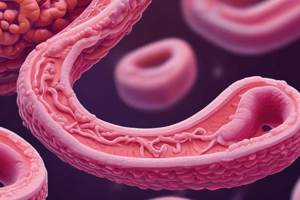Podcast
Questions and Answers
What is the primary characteristic of ulcerative colitis according to the text?
What is the primary characteristic of ulcerative colitis according to the text?
- Progressive scarring and narrowing of the bowel lumen
- Inflammation limited to the colonic mucosa (correct)
- Involvement of the full thickness of the bowel wall
- Inflammation throughout the entire bowel wall
Which of the following diagnostic procedures is NOT mentioned in the text?
Which of the following diagnostic procedures is NOT mentioned in the text?
- Magnetic resonance imaging (MRI) (correct)
- Blood tests
- Endoscopy
- Stool analysis
Which of the following is a potential new treatment approach for inflammatory bowel diseases?
Which of the following is a potential new treatment approach for inflammatory bowel diseases?
- Organ transplantation
- Radiation therapy
- Antibiotic therapy
- Gut microbiome manipulation (correct)
What is the estimated percentage of patients with inflammatory bowel disease that are diagnosed with ulcerative colitis according to the text?
What is the estimated percentage of patients with inflammatory bowel disease that are diagnosed with ulcerative colitis according to the text?
Which of the following is NOT mentioned in the text as a medication used to treat inflammatory bowel diseases?
Which of the following is NOT mentioned in the text as a medication used to treat inflammatory bowel diseases?
Which of the following is a characteristic of the patient population affected by ulcerative colitis?
Which of the following is a characteristic of the patient population affected by ulcerative colitis?
Which of the following statements about Crohn's disease is correct?
Which of the following statements about Crohn's disease is correct?
Which of the following is NOT a common symptom of inflammatory bowel disease (IBD)?
Which of the following is NOT a common symptom of inflammatory bowel disease (IBD)?
In the diagnosis of inflammatory bowel disease (IBD), which of the following is NOT typically required?
In the diagnosis of inflammatory bowel disease (IBD), which of the following is NOT typically required?
Which of the following statements about ulcerative colitis and Crohn's disease is correct?
Which of the following statements about ulcerative colitis and Crohn's disease is correct?
Which of the following is NOT a potential complication of inflammatory bowel disease (IBD) mentioned in the text?
Which of the following is NOT a potential complication of inflammatory bowel disease (IBD) mentioned in the text?
Which age group is most commonly affected by Crohn's disease?
Which age group is most commonly affected by Crohn's disease?
Study Notes
Inflammatory Bowel Disease (IBD): Understanding Crohn's Disease, Symptoms, Diagnosis, and Treatment Options
Introduction
Inflammatory bowel disease (IBD) is a group of chronic inflammatory conditions that primarily affect the gastrointestinal tract. The two main forms of IBD are Crohn's disease (CD) and ulcerative colitis (UC). These diseases are marked by inflammation and mucosal destruction in the intestines, often causing significant discomfort and complications. Here, we will explore each subtopic related to IBD, starting with Crohn's disease.
Crohn's Disease
Crohn's disease is known for its ability to affect any part of the gastrointestinal tract, often spreading deep into the tissue layers. However, prior studies suggest that it typically occurs between the ages of 15 and 35 years and tends to affect women more frequently than men. Smoking plays a role in preventing ulcerative colitis but increases the risk of developing Crohn's disease.
Symptoms
Symptoms of IBD vary depending on the type and severity of the disease. They may include persistent diarrhea, crampy abdominal pain, rectal bleeding, and unexplained weight loss. Fatigue, loss of appetite, and a general feeling of unwellness are other common symptoms. Children with IBD may experience growth delays and delayed sexual maturation.
Diagnosis
Diagnosing IBD requires a thorough understanding of the patient's medical history, physical examination, and a series of tests. Blood tests, stool analysis, imaging studies like CT enterography, and invasive procedures like endoscopy and biopsy may be employed to make a definitive diagnosis.
Treatment Options
Although there is no cure for IBD, various treatments can help manage the symptoms and prevent complications. Medications like aminosalicylates, corticosteroids, immunosuppressants, and biological agents target specific aspects of the immune response and inflammation process. Other approaches, such as gut microbiome manipulation and stem cell transplantation, show promise in treating IBD.
Ulcerative Colitis
Ulcerative colitis is characterized by inflammation limited to the colonic mucosa and may extend to involve the full thickness of the bowel wall, leading to progressive scarring and narrowing of the bowel lumen. Roughly 30-45% of patients with IBD are diagnosed with UC. The disease is more common in women and typically affects people in their late teens to early adulthood, although the elderly population has also been reported to be affected.
Conclusion
Inflammatory bowel diseases like Crohn's disease and ulcerative colitis pose significant challenges for patients due to their chronic nature. While there is no cure, ongoing research and advancements in treatment options offer hope for managing symptoms and improving quality of life. As always, it is essential to consult a healthcare professional for accurate information, diagnoses, and treatment plans tailored to individual cases.
Studying That Suits You
Use AI to generate personalized quizzes and flashcards to suit your learning preferences.
Description
Test your knowledge on the chronic inflammatory conditions affecting the gastrointestinal tract known as Inflammatory Bowel Disease (IBD), focusing on Crohn's disease, its symptoms, diagnosis methods, and available treatment options. Explore the key aspects of Crohn's disease, including its impact on different age groups and genders, common symptoms, diagnostic procedures, and various management approaches.




